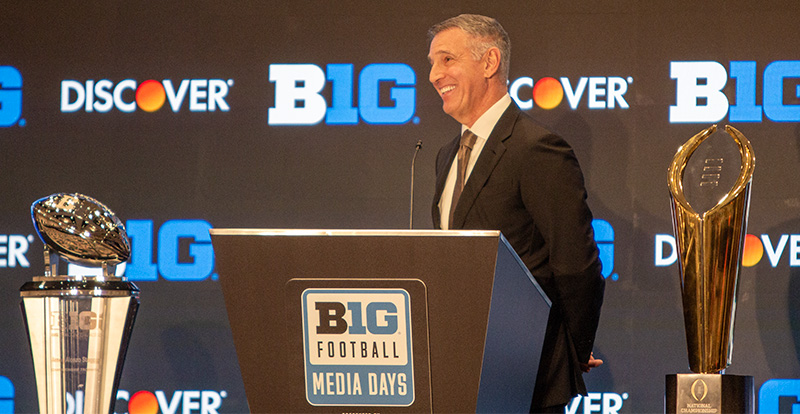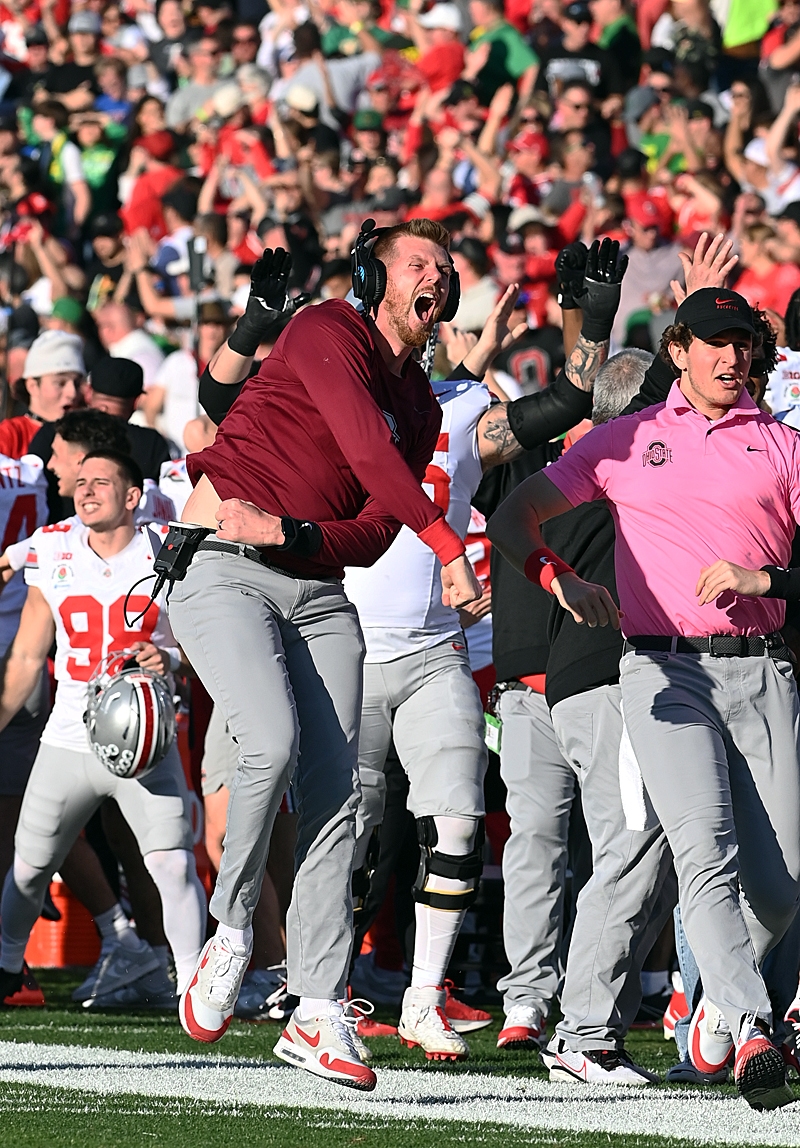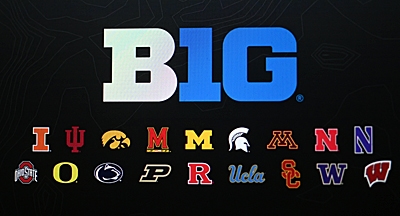
Big Ten commissioner Tony Pettiti……
Commissioner Tony Petitti continued to talk Tuesday at Big Ten Media Days about expanding the playoffs to 16 and guaranteeing four spots for Big Ten and SEC teams. And the coaches, one by one, took the stage and made the same arguments.
 Las Vegas, NV – This transformational era of college football needs leaders with good ideas, coaches not afraid to speak their minds and leagues not afraid to lead the pack.
Las Vegas, NV – This transformational era of college football needs leaders with good ideas, coaches not afraid to speak their minds and leagues not afraid to lead the pack.
The Big Ten – 18 teams strong – wants to be that group. The conference wants to continue to influence the direction of the sport. The expansion to the West Coast and 18 teams positioned them well to say move over SEC. The league’s success in the 12-team playoff last year and the producing of consecutive national champions plants the Big Ten flag on a higher mountain.
Now the Big Ten wants more.

Veteran columnist Jeff Gilbert writes Ohio State basketball and OHSAA sports for Press Pros Magazine.com.
Commissioner Tony Petitti began Big Ten Media Days on Tuesday talking about the league and its aspirations. He stayed true to his idea that the Big Ten and SEC deserve four automatic bids into a playoff that he envisions at 16 teams. That would leave two each for the ACC and Big 12, one to the highest ranked Group of Six champion and three at-large bids.
The Big Ten and SEC have more players on the ice, so to speak, so they are counting on winning the power-play advantage.
Petitti wants a Big Ten championship Saturday of play-in games – 3 vs. 6, 4 vs. 5 – to determine the league’s third and fourth playoff qualifiers. That’s in addition to the 1 vs. 2 title game to determine the league’s champion and first two qualifers. And, who knows, maybe one of the losers that day is good enough to earn one of the three at-large bids. The Big Ten thinks that’s possible.
“We want to better connect the regular season and the postseason,” Petitti began his petition, a scripted statement before he took questions. “A critical goal of any postseason format, regardless of sport, is to keep as many teams alive as deep into the season as possible. We want more conference games to matter in November.”
Petitti also wants additional automatic bids to encourage good nonconference scheduling such as Ohio State’s opener this season against Texas. And he wants more objective results and fewer subjective results by the College Football Playoff committee to determine an eventual field of 16. Time is running out for this season’s playoff to be more than 12 teams.
“As we said throughout this process, we are open to considering any format ideas that come from our colleagues or the CFP staff,” Petitti said. “But to be clear, formats that increase the discretion and role of the CFP selection committee will have a difficult time gaining support from the Big 10.”

“You’re less likely to play a game like Texas moving forward, which I think is great for college football,” says Ryan Day. “I mean, how excited is everyone going to be across the country to watch this first game?”
Then the coaches began their 15 minutes on stage and presented a unified front. The six who spoke Tuesday, to a man and including Ohio State’s Ryan Day, thanked Petitti for his leadership in the new revenue sharing model for players and in the push for the playoff model he is championing.
Bret Bielema of Illinois followed Petitti, and, as if scripted, Bielema spoke his mind as he always does. He was asked about being a voice for coaches, and his answer fit everything Petitti is advocating for.
“If you don’t stand up for yourself, who will,” Bielema said.
Last year four Big Ten and four SEC teams were selected to the 12-team field. Petitti’s model is meant to ensure that same representation every year. But in case anyone is mistaken as to why Petitti believes he speaks from a position of strength, Indiana coach Curt Cignetti spoke in concrete terms as he always does.
“The two best conferences in college football, any football guy who’s objective will tell you it’s the Big Ten and the SEC,” he said with more authority than an AI-aided Google query.
Petitti advocates for his idea because, he says, he wants to take pressure off the committee. He said there’s too much data and criteria to sort through. Let it be decided on the field as much as possible.
Actually, when the Big Ten was 10, then 11, then 12 teams, it was decided more on the field. With 18 teams, two contenders might have vastly different league schedules and not even play each other. But there’s no going back from 18 teams. If anything, the Big Ten will be the Big Twenty before long.
Schedules do play a role in these negotiations. The Big Ten plays nine conference games. The SEC plays eight. Cignetti, of course, has a solution aimed at the SEC adding a ninth conference game.
“We need to standardize the schedule across the board if we want to have objective criteria of who should be in the playoffs,” he said. “And we need to take the decision making off the committee to some degree.”
Standardized scheduling means convincing the SEC to play nine leagues instead of eighth.
Ohio State, as a perennial top-of-the-league program, might not continue to schedule games like Texas if the imbalance of league schedules continues. Why? Because, Day said, playing one more conference game is more significant than at first glance. It adds a loss for some contenders because it eliminates a nonconference game that all the top SEC teams win every year against a Group of Six or FCS opponent.
“You’re less likely to play a game like Texas moving forward, which I think is great for college football,” Day said. “I mean, how excited is everyone going to be across the country to watch this first game?
 “If we’re going to be in a situation where we get four automatic qualifiers, then I think it’d be great to have a 10th game against a power four team. If we’re not going to do that, then you have your nine conference games and schedule other games that maybe aren’t the power four.”
“If we’re going to be in a situation where we get four automatic qualifiers, then I think it’d be great to have a 10th game against a power four team. If we’re not going to do that, then you have your nine conference games and schedule other games that maybe aren’t the power four.”
The Big Ten is advocating for itself, which means Petitti, along with coaches and ADs voicing support, aren’t afraid to pressure the SEC and threaten to not play games like OSU-Texas. Because when decision time comes, those two leagues will dominate the discussions and the decisions.
The Big Ten has the past two national champions. They are in a powerful position and they are acting and talking like it.




